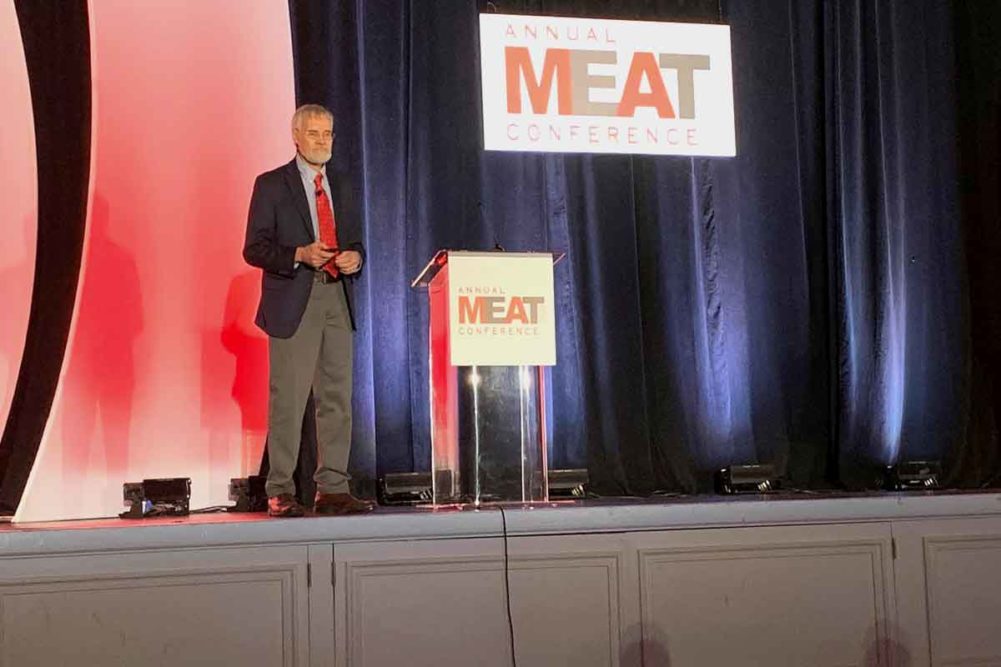NASHVILLE, TENN. – The second day of the Annual Meat Conference always opens with a “Market Outlook” presentation on the state of the poultry, beef and pork industries. On March 3, Paul Aho, economist and consultant for the Poultry Perspective, Randy Blach, chief executive officer of Cattlefax, and Steve Meyer, economist for Kerns & Associates, presented their “state of the market” to a packed ballroom at the Gaylord Opryland Resort and Convention Center in Nashville.
The coronavirus and its potential impact on the meat industries led the discussion. Aho told attendees that it’s too soon to know the impact the coronavirus will have on the country, the world and the meat industry.
“The short-term impact of the coronavirus is that it could affect consumption, distribution, production and trade,” Aho said. “It could lower the price of meat and start a worldwide recession – it’s too soon to tell.
“If we have social distancing and meetings are canceled and people aren’t going out to eat that could reduce the demand for meat of all kind. Chicken would probably be affected more than other meats in that scenario.”
Reducing demand for meat isn’t good for the industry, but when it comes to poultry, “we have way too many chickens,” Aho said.
Between 2018 and 2020, there was a large increase in total meat use. Pork and beef were up 1.2 billion lbs and poultry was up 2.8 billion lbs.
“We have a lot of meat available right now,” he said.
The Chinese market is now open to US chicken, which is a “bright spot” for the poultry industry. China will buy $600 million worth of poultry paws (a poultry part that doesn’t sell well in the United States). The income from those exports will go straight to the bottom line and will help bring in at least $1 billion a year from increased sales to China, Aho said.
“Pork has been the king of meats for many years, back in 2018 I thought maybe in 10 years, maybe in 20 years, chicken will take over,” Aho said. “But thanks to African swine fever, chicken became the king of meats last year.”
Blach’s prediction for 2020 meat production – poultry will be up 3% (1.7 billion lbs), pork will be up 4% (1.1 billion lbs) and beef will be up 2% (600 million lbs).
“With our record production for all proteins right now it’s important that we are able to export,” Blach said. “So far, consumer attitudes toward meat have been excellent. It’s been great that we’ve been able to hold on to market share despite all the meat alternatives on the market – but that could change.”
When it comes to the pork market, it all comes down to African swine fever – it’s a “global protein game changer,” Meyer said.
Why is it a “game changer?” First, the virus is very hard to kill – and it remains present in feces, fluids and even in meat products. While the disease is harmless to humans, it is deadly to swine (with a 95+% mortality rate). The virus causes a hemorrhagic disease in pigs, warthogs, European wild boar and American feral pigs. There is currently no vaccine.
Seventy-five percent of the world’s pigs in Asia and the European Union are now threatened with the disease. China’s pork supply is 20% of the total world supply of meat and poultry.
Back in October, the Chinese government reported that pork inventory was down 40% and slaughter was down 46%.
At least 65% of China’s pig herd is gone, which is one-third of the pigs on the planet, said Brett Stuart, president of Global AgriTrends.
How fast will China recover? Meyer said, 70% recovery of the Chinese pork market would still mean importing 30% of the country’s total consumption.
“Without an effective vaccine for ASF, recovery is doubtful,” he said.
Editor’s note: With the coronavirus pandemic changing on a day-to-day basis it’s challenging to predict what will happen with any part of the food industry. These economists’ predictions were made two weeks ago before schools and restaurants around the country were closed in an effort to control the spread of the virus.




